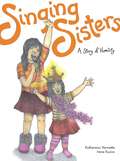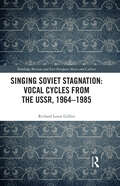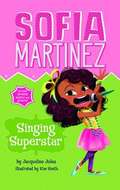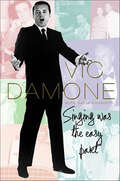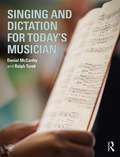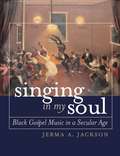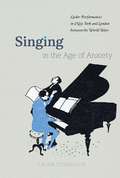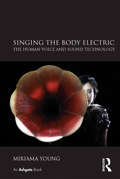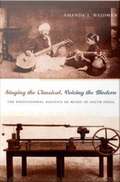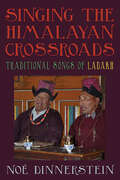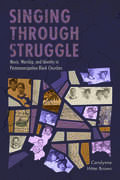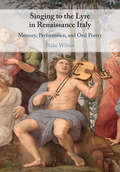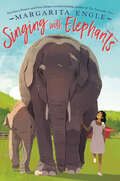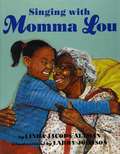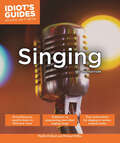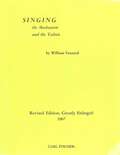- Table View
- List View
Singing Sisters: A Story of Humility (The Seven Teachings Stories #2)
by Katherena VermetteMa&’iingan loves to sing and her family loves to hear her beautiful voice. Her little sister wants to sing just like Ma&’iingan, but Ma&’iingan doesn&’t want her to. As rivalry erupts between the siblings, can Ma&’iingan find the humility to share her talent with her sister?In this relatable story, a young Anishinaabe girl learns to put aside her pride and sibling rivalry to share her love of singing with her sister. A pronunciation guide for the Anishnaabemowin words can be found at the back of the book.Rich in culture and grounded in traditional knowledge, Katherena Vermette&’s The Seven Teachings Stories series features themes of love, wisdom, humility, courage, respect, honesty, and truth. Contemporary Indigenous children explore the Seven Teachings of the Anishinaabe through stories of home and family that will look familiar to all young readers in these books for ages 3–5.
Singing Sisters: A Story of Humility (The Seven Teachings Stories #2)
by Katherena VermetteMa&’iingan loves to sing and her family loves to hear her beautiful voice. Her little sister wants to sing just like Ma&’iingan, but Ma&’iingan doesn&’t want her to. As rivalry erupts between the siblings, can Ma&’iingan find the humility to share her talent with her sister?In this relatable story, a young Anishinaabe girl learns to put aside her pride and sibling rivalry to share her love of singing with her sister. A pronunciation guide for the Anishnaabemowin words can be found at the back of the book.Rich in culture and grounded in traditional knowledge, Katherena Vermette&’s The Seven Teachings Stories series features themes of love, wisdom, humility, courage, respect, honesty, and truth. Contemporary Indigenous children explore the Seven Teachings of the Anishinaabe through stories of home and family that will look familiar to all young readers in these books for ages 3–5.
Singing Soviet Stagnation: Vocal Cycles from the USSR, 1964–1985 (Routledge Russian and East European Music and Culture)
by Richard Louis GilliesSinging Soviet Stagnation: Vocal Cycles from the USSR, 1964–1985 explores the ways in which the aftershock of an apparent crisis in Soviet identity after the death of Stalin in 1953 can be detected in selected musical-literary works of what has become known as the ‘Stagnation’ era (1964–1985). Richard Louis Gillies traces the cultural impact of this shift through the intersection between music, poetry, and identity, presenting close readings of three substantial literary-musical works by three of the period’s most prominent composers of songs and vocal cycles: Seven Poems of Aleksandr Blok, Op. 127 (1966–1967) by Dmitri Shostakovich (1906–1975) Russia Cast Adrift (1977) by Georgy Sviridov (1915–1998) Stupeni (1981–1982; 1997) by Valentin Silvestrov (b. 1937). The study elaborates an interdisciplinary approach to the analysis of musical-literary artworks that does not rely on existing models of musical analysis or on established modes of literary criticism, thereby avoiding privileging one discipline over the other. It will be of particular significance for scholars, students, and performers with an interest in Russian and Soviet music, the intersection between music and poetry, and the history of Russian and East European culture, politics, and identity during the twentieth century.
Singing Superstar (Sofia Martinez Ser.)
by Jacqueline Jules Kim SmithSofia's family does not want to hear her singing anymore, so she must find the appropriate place to use her new superstar-sing box machine.
Singing Was the Easy Part
by David Chanoff Vic DamoneBorn Vito Farinola in Bensonhurst, Brooklyn in 1928, Vic worked as an usher at the fabled Paramount Theatre before realizing a dream by shooting to the top of the Billboard Chart in 1947 with his first hit "I Have But One Heart." He was mentored by everyone from Perry Como to Tommy Dorsey. Frank Sinatra praised his voice and became a friend for life, giving him advice on singing and women. Damone had one of the most successful careers ever had by an American pop singer and one of the most glamorous and exciting lives of any guy who lived while the Ratpack reigned. • He was almost thrown out of the window of a New York City hotel by a mobster. • He dated Ava Gardner, who got him drunk for the first time. • He married glamorous Italian actress Ana Maria Pierangeli and later, Diahann Carroll. • He appeared at the Sands Hotel during the glory days of Vegas and once took a nude chorus girl into the steam room where the Ratpack was relaxing. In Singing Was the Easy Part, he talks frankly about his bankruptcy, his many marriages and his belief in God. It's a warm, funny, and inspiring memoir from one of America's greatest pop singers.
Singing Yoruba Christianity: Music, Media, and Morality
by Vicki L. BrennanSinging the same song is a central part of the worship practice for members of the Cherubim and Seraphim Christian Church in Lagos, Nigeria. Vicki L. Brennan reveals that by singing together, church members create one spiritual mind and become unified around a shared set of values. She follows parishioners as they attend choir rehearsals, use musical media—hymn books and cassette tapes—and perform the music and rituals that connect them through religious experience. Brennan asserts that church members believe that singing together makes them part of a larger imagined social collective, one that allows them to achieve health, joy, happiness, wealth, and success in an ethical way. Brennan discovers how this particular Yoruba church articulates and embodies the moral attitudes necessary to be a good Christian in Nigeria today.
Singing Zarzuela, 1869–1958: Approaching Portamento and Musical Expression through Historical Recordings (Elements in Musical Theatre)
by Eva Moreda RodríguezIn the last few years, digitizations and reissues of historical recordings of Spanish zarzuela - from wax cylinders in the 1890s to long-play records in the 1950s - have revealed a range of contrasting vocal performance styles. By focusing on portamento, this Element sets the foundations for a contextually sensitive history of vocal performance practices in zarzuela. It takes stock of technological changes and shifts in commercial strategies and listening habits to reveal what the recorded evidence tells us about the historical development of portamento practices and considers how these findings can allow us to reconstruct the expressive code of zarzuela as it was performed in the late nineteenth century and how it transformed itself throughout the next half century. These transformations are contextualized alongside other changes, including the make-up of audiences, the discourses about the genre's connection to national identity and the influence of other musical-theatrical genres and languages.
Singing and Communicating in English: A Singer's Guide to English Diction
by Kathryn LaBouffInternationally known vocal coach Kathryn LaBouff provides singers with the valuable principles of English diction they need to communicate through song. Her much sought-after technique teaches singers to practice neutral pronunciation, clarify the physiology of speech, and emphasize the study of English cadence.
Singing and Dictation for Today's Musician
by Ralph Turek Daniel McCarthySinging and Dictation for Today's Musician expands the Today's Musician family of textbooks to encompass the essential elements of musicianship and aural skills training. Featuring chapters that correspond to the organization of Theory for Today's Musician, this new textbook complements the theory text to offer a complete curriculum package, allowing students and instructors to reinforce written theory skills with relevant musicianship exercises. Combining sight singing and dictation in a single volume, this new textbook underscores the value of combining the human senses in understanding the intellectual and analytic concepts of music theory. Features of this text include: Flexibility for the instructor in using moveable or fixed "Do," scale degree numbers, and neutral syllables for singing Both singing and dictation exercises included in each unit, allowing the two skills to be fully integrated Companion website with audio recordings and instructor keys for the exercises, at www.routledge.com/cw/mccarthy Units match the pacing and order of topics in Theory for Today’s Musician, allowing the texts to be easily used in sync. Beginning with fundamentals and continuing up through twentieth-century materials, Singing and Dictation for Today’s Musician allows instructors to closely align their teaching of musicianship and aural skills with the written theory curriculum, enhancing student understanding of core music principles.
Singing and Wellbeing: Ancient Wisdom, Modern Proof
by Kay NortonSinging and Wellbeing provides evidence that the benefits of a melodious voice go far beyond pleasure, and confirms the importance of singing in optimum health. A largely untapped resource in the health care professions, the singing voice offers rewards that are closer than ever to being fully quantified by advances in neuroscience and psychology. For music, pre-med, bioethics, and medical humanities students, this book introduces the types of ongoing research that connect behaviour and brain function with the musical voice.
Singing in My Soul
by Jerma A. JacksonBlack gospel music grew from obscure nineteenth-century beginnings to become the leading style of sacred music in black American communities after World War II. Jerma A. Jackson traces the music's unique history, profiling the careers of several singers--particularly Sister Rosetta Tharpe--and demonstrating the important role women played in popularizing gospel.Female gospel singers initially developed their musical abilities in churches where gospel prevailed as a mode of worship. Few, however, stayed exclusively in the religious realm. As recordings and sheet music pushed gospel into the commercial arena, gospel began to develop a life beyond the church, spreading first among a broad spectrum of African Americans and then to white middle-class audiences. Retail outlets, recording companies, and booking agencies turned gospel into big business, and local church singers emerged as national and international celebrities. Amid these changes, the music acquired increasing significance as a source of black identity.These successes, however, generated fierce controversy. As gospel gained public visibility and broad commercial appeal, debates broke out over the meaning of the music and its message, raising questions about the virtues of commercialism and material values, the contours of racial identity, and the nature of the sacred. Jackson engages these debates to explore how race, faith, and identity became central questions in twentieth-century African American life.
Singing in the Age of Anxiety: Lieder Performances in New York and London between the World Wars
by Laura TunbridgeIn New York and London during World War I, the performance of lieder—German art songs—was roundly prohibited, representing as they did the music and language of the enemy. But as German musicians returned to the transatlantic circuit in the 1920s, so too did the songs of Franz Schubert, Hugo Wolf, and Richard Strauss. Lieder were encountered in a variety of venues and media—at luxury hotels and on ocean liners, in vaudeville productions and at Carnegie Hall, and on gramophone recordings, radio broadcasts, and films. Laura Tunbridge explores the renewed vitality of this refugee musical form between the world wars, offering a fresh perspective on a period that was pervaded by anxieties of displacement. Through richly varied case studies, Singing in the Age of Anxiety traces how lieder were circulated, presented, and consumed in metropolitan contexts, shedding new light on how music facilitated unlikely crossings of nationalist and internationalist ideologies during the interwar period.
Singing the Body Electric: The Human Voice And Sound Technology
by Miriama YoungSinging the Body Electric explores the relationship between the human voice and technology, offering startling insights into the ways in which technological mediation affects our understanding of the voice, and more generally, the human body. From the phonautograph to magnetic tape and now to digital sampling, Miriama Young visits particular musical and literary works that define a century-and-a-half of recorded sound. She discusses the way in which the human voice is captured, transformed or synthesised through technology. This includes the sampled voice, the mechanical voice, the technologically modified voice, the pliable voice of the digital era, and the phenomenon by which humans mimic the sounding traits of the machine. The book draws from key electro-vocal works spanning a range of genres - from Luciano Berio's Thema: Omaggio a Joyce to Radiohead, from Alvin Lucier's I Am Sitting in a Room, to Björk, and from Pierre Henry's Variations on a Door and a Sigh to Christian Marclay's Maria Callas. In essence, this book transcends time and musical style to reflect on the way in which the machine transforms our experience of the voice. The chapters are interpolated by conversations with five composers who work creatively with the voice and technology: Trevor Wishart, Katharine Norman, Paul Lansky, Eduardo Miranda and Bora Yoon. This book is an interdisciplinary enterprise that combines music aesthetics and musical analysis with literature and philosophy.
Singing the Classical, Voicing the Modern: The Postcolonial Politics of Music in South India
by Amanda J. WeidmanWhile Karnatic music, a form of Indian music based on the melodic principle of raga and time cycles called tala, is known today as South India's classical music, its status as "classical" is an early-twentieth-century construct, one that emerged in the crucible of colonial modernity, nationalist ideology, and South Indian regional politics. As Amanda J. Weidman demonstrates, in order for Karnatic music to be considered classical music, it needed to be modeled on Western classical music, with its system of notation, composers, compositions, conservatories, and concerts. At the same time, it needed to remain distinctively Indian. Weidman argues that these contradictory imperatives led to the emergence of a particular "politics of voice," in which the voice came to stand for authenticity and Indianness. Combining ethnographic observation derived from her experience as a student and performer of South Indian music with close readings of archival materials, Weidman traces the emergence of this politics of voice through compelling analyses of the relationship between vocal sound and instrumental imitation, conventions of performance and staging, the status of women as performers, debates about language and music, and the relationship between oral tradition and technologies of printing and sound reproduction. Through her sustained exploration of the way "voice" is elaborated as a trope of modern subjectivity, national identity, and cultural authenticity, Weidman provides a model for thinking about the voice in anthropological and historical terms. In so doing, she shows that modernity is characterized as much by particular ideas about orality, aurality, and the voice as it is by regimes of visuality.
Singing the English: Britain in the French Musical Lowbrow, 1870–1904 (Music in Nineteenth-Century Britain)
by Hannah L. ScottLate nineteenth-century France was a nation undergoing an identity crisis: the uncertain infancy of the Third Republic and shifting alliances in the wake of the Franco-Prussian War forced France to interrogate the fundamental values and characteristics at the heart of its own national identity. Music was central to this national self-scrutiny. It comes as little surprise to us that Oriental fears, desires, and anxieties should be a fundamental part of this, but what has been overlooked to date is that Britain, too, provided a thinking space in the French musical world; it was often – surprisingly and paradoxically – represented through many of the same racialist terms and musical tropes as the Orient. However, at the same time, its shared history with France and the explosions of colonial rivalry between the two nations introduced an ever-present tension into this musical relationship. This book sheds light on this forgotten musical sphere through a rich variety of contemporary sources. It visits the café-concert and its tradition of ‘Englishing up’ with fake hair, mocking accents, and unflattering dances; it explores the reactions, both musical and physical, to British evangelical bands as they arrived in the streets of France and the colonies; it considers the French reception of, and fascination with, folk music from Ireland and Scotland; and it confronts the culture shock felt by French visitors to Britain as they witnessed British music-making for the first time. Throughout, it examines the ways in which this music allowed French society to grapple with the uncertainty of late nineteenth-century life, providing ordinary French citizens with a means of understanding and interrogating both the Franco-British relationship and French identity itself.
Singing the Gospel along Scotland’s North-East Coast, 1859–2009 (SOAS Musicology Series)
by Frances WilkinsFollowing three years of ethnomusicological fieldwork on the sacred singing traditions of evangelical Christians in North-East Scotland and Northern Isles coastal communities, Frances Wilkins documents and analyses current singing practices in this book by placing them historically and contemporaneously within their respective faith communities. In ascertaining who the singers were and why, when, where, how and what they chose to sing, the study explores a number of related questions. How has sacred singing contributed to the establishment and reinforcement of individual and group identities both in the church and wider community? What is the process by which specific regional repertoires and styles develop? Which organisations and venues have been particularly conducive to the development of sacred singing in the community? How does the subject matter of songs relate to the immediate environment of coastal inhabitants? How and why has gospel singing in coastal communities changed? These questions are answered with comprehensive reference to interview material, fieldnotes, videography and audio field recordings. As one of the first pieces of ethnomusicological research into sacred music performance in Scotland, this ethnography draws important parallels between practices in the North East and elsewhere in the British Isles and across the globe.
Singing the Himalayan Crossroads: Traditional Songs of Ladakh
by Noé DinnersteinIntroduces the traditional songs of Himalayan Ladakh through their history, ethnology, poetry, and Tibetan Buddhism beliefs.Singing the Himalayan Crossroads places the traditional song repertoires of the former Himalayan kingdom of Ladakh in both their historical and modern contexts. Although scholarly, it is aimed at a broad general audience, including people interested in ethnomusicology, Tibet, Buddhism, the Silk Road, or the music and cultures of Central and South Asia.While many songs contain texts that evoke Buddhist meditative visualization practices, at the same time, Muslims, both Sunni and Shia, were prominent in Silk Road caravans that enriched the Buddhist aristocracy. Songs from these Muslim traders often mention important religious sites in Kashmir while having nostalgia for the sights of the Ladakhi capital, Leh. Interweaving these themes, author Noé Dinnerstein mixes a relaxed, conversational narrative with the music and poetry of the songs to evoke the crossroads of High Asia.A separate anthology of recordings is available online.
Singing through Struggle: Music, Worship, and Identity in Postemancipation Black Churches
by Carolynne Hitter BrownSinging through Struggle: Music, Worship, and Identity in Postemancipation Black Churches offers an innovative look at the vital role music and worship played in nurturing Black citizenship and identity during the Reconstruction era. In such border cities as Baltimore, Washington, DC, and Philadelphia, the church was where newly emancipated migrants and members of the free Black community merged identities, priorities, and experiences through a process of cultural negotiation. Music, as a sign of Black achievement and as a genuine expression of identity, produced both bastions and battlegrounds in the fight for democracy.The music of Black churchgoers, singing together in sanctuaries as well as in homes, schools, and outdoors, expressed resistance to uplift ideologies within and to white supremacy without. Even while using hymns and music of the European sacred tradition, members infused the songs they chose with new meanings relevant to their evolving concerns and situations. Drawing on fresh archival sources, Singing through Struggle sheds light on the unexplored gap in the study of African American religious music between slavery and the Great Migration, demonstrating the continuous stream of Black creativity and dignity that existed in religious music making between gospel music and the spirituals. This close-up investigation of three Black congregations draws out previously forgotten stories of men and women who understood church music as key to shaping a collective purpose and civic identity. Their stories demonstrate how faith, music, and ritual gave the Black community means for exploring a deeply complex and ever-changing reality.
Singing to the Lyre in Renaissance Italy: Memory, Performance, and Oral Poetry
by Blake WilsonA primary mode for the creation and dissemination of poetry in Renaissance Italy was the oral practice of singing and improvising verse to the accompaniment of a stringed instrument. Singing to the Lyre is the first comprehensive study of this ubiquitous practice, which was cultivated by performers ranging from popes, princes, and many artists, to professionals of both mercantile and humanist background. Common to all was a strong degree of mixed orality based on a synergy between writing and the oral operations of memory, improvisation, and performance. As a cultural practice deeply rooted in language and supported by ancient precedent, cantare ad lyram (singing to the lyre) is also a reflection of Renaissance cultural priorities, including the status of vernacular poetry, the study and practice of rhetoric, the oral foundations of humanist education, and the performative culture of the courts reflected in theatrical presentations and Castiglione's Il cortegiano.
Singing with Elephants
by Margarita EngleA powerful novel in verse from Newbery and Pura Belpré Award-winning author Margarita Engle about the friendship between a young girl and the poet Gabriela Mistral that leads to healing and hope for both of them.Cuban-born eleven-year-old Oriol lives in Santa Barbara, California, where she struggles to belong. But most of the time that's okay, because she enjoys helping her parents care for the many injured animals at their veterinary clinic. Then Gabriela Mistral, the first Latin American winner of a Nobel Prize in Literature, moves to town, and aspiring writer Oriol finds herself opening up. As she begins to create a world of words for herself, Oriol learns it will take courage to stay true to herself and do what she thinks is right--attempting to rescue a baby elephant in need--even if it means keeping secrets from those she loves. A beautifully written, lyrically told story about the power of friendship-- between generations, between humans and animals--and the potential of poetry to inspire action and acceptance. * "Replete with lovely, nearly magical imagery...Brilliant, joyful, and deeply moving." -Kirkus, starred review * "Employing immersive free verse that conveys themes of compassion, friendship, justice, and vulnerability, Engle captures how inexplicable Oriol&’s grief feels, encasing it in a powerful, charitable, and brave young voice." -Publishers Weekly, starred review * "A novel written in verse that sings in your heart." -Pura Belpré Award-winning author Marjorie Agosín
Singing with Momma Lou
by Linda Jacobs Altman Larry JohnsonNine-year-old Tamika Jordan dreads visiting her grandmother at the nursing home. Momma Lou has Alzheimer's and always forgets who Tamika is. After her father shows her Momma Lou's scrapbooks, Tamika comes up with an idea to jog Momma Lou's memory. Tamika is successful in reaching her grandmother one day when Momma Lou recognizes a newspaper clipping of a Civil Rights demonstration and leads everybody in a celebration of song. Linda Jacobs Altman tells a moving story of intergenerational love and hope, while Larry Johnson's evocative paintings bring this memorable story to life. This a book to be shared by the whole family. Altman learned about the effects of Alzheimer s when her mother was stricken with the disease. While it was a tragic experience, she learned from her mother the power of the human spirit.
Singing, Second Edition (Idiot's Guides)
by Michael Miller Phyllis FulfordNow with helpful audio examples available online, Idiot's Guides: Singing, Second Edition, is a fast-track approach to improving vocal technique, including solo, ensemble, and sight singing. Filled with illustrations and exercises, this book covers different musical styles — from pop and rock to country and classical.
Singing: The Mechanism and the Technic
by William VennardThis mechanistic book is an attempt to compile under one cover objective findings from various reliable sources and to relate them to the art of singing. There are those teachers who feel that applying science to an art is quackery, but some believe that our only safeguard against the charlatan is general knowledge of the most accurate information available. Whether you are a singer or a teacher of singing, you will find something to profitably add to your philosophy. This edition includes much more exact information.
Sinéad O'Connor: and Other Conversations (The Last Interview Series)
by Kristin Hersh Melville HouseA significant collection of interviews with the defiant, controversial, and ground-breaking singer, songwriter, and activist throughout her turbulent career . . .&“It&’s not like I got up in the morning and said, &‘Okay, now let&’s start a new controversy&’.&” -- Sinéad O&’ConnorSinéad O'Connor&’s music — both in her songwriting and in her beautiful voice —addressed both emotional despair and incandescent joy with glorious ardor. But she may have been just as well known for her outspokenness. This collection of interviews covers the entire span of O'Connor's career, from the early days to her last interview. From giddy teenager to seasoned superstar, she speaks candidly about her meteoric rise to fame, and recounts what happened when she ripped up a photo of Pope John Paul II on live television in an act of protest. Unguarded and unpredictable, O'Connor was a woman who electrified the globe: imaginative, opinionated, and eloquent.
Sip Me, Baby, One More Time: Cocktails Inspired by Pop Music's Iconic Women
by Ashley GibsonMy thirstiness is killing me . . . As gorgeous as your favorite album art and as irresistible as a catchy hook, a collection of stunning (and stunningly easy) cocktail recipes based on pop songs by iconic women. With a great drink in your hand and the perfect song playing, you can transform any place into your own personal party. Pop music is unmatched when it comes to capturing a feeling, and this book is inspired by the great songs and women who define this genre, as well as some lesser-known artists whose music is as exciting as stumbling upon a new favorite liqueur that adds just the flavor you&’ve been missing.Sip Me, Baby, One More Time combines the art of cocktail making with the power of these artists to create an experience curated by emotion. Each chapter of this book is a journey through a playlist dedicated to a specific feeling—from coping with soul-crushing heartbreak to feeling like you want to hop on a table and dance it out—and is filled with easy to make, beautiful cocktails dedicated to tracks from top female artists.Featuring drinks inspired by songs from Britney Spears, Beyoncé, Taylor Swift, Rihanna, Ariana Grande, Lana Del Rey, BLACKPINK, The Spice Girls, Doja Cat, and many more.
